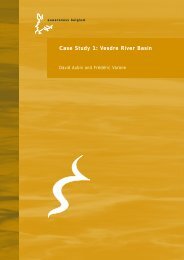Case Study 1: Matarraña River Basin - Euwareness
Case Study 1: Matarraña River Basin - Euwareness
Case Study 1: Matarraña River Basin - Euwareness
You also want an ePaper? Increase the reach of your titles
YUMPU automatically turns print PDFs into web optimized ePapers that Google loves.
Both the dominance of the middle basin actors in the decisions regarding the<br />
distribution of water coming from the Pena dam, and the existence of illegal users all<br />
around the river basin, but especially in the middle basin, are a source of continuous<br />
conflict among users and among municipalities. Conflict is specially intense during<br />
spring and summer seasons because of water scarcity (this is the period in which<br />
illegal users are not allowed to take water from the river but in which they need it in<br />
more quantities). The lower basin irrigation communities often feel damaged by the<br />
decisions taken by the Central Union, as they consider that the latter mostly satisfies<br />
the interests of the middle basin. In addition, illegal users, even though they pay for the<br />
use of water, have less use rights than the legal ones, but may benefit from the fact of<br />
being located in upper parts of the basin by means of, for instance, taking water at<br />
night or using water when the lower basin irrigation communities have a preference<br />
because of being legal.<br />
Conflict resolution<br />
According to the regulative system, conflicts emerging in users communities are to be<br />
solved: the general community when conflict confronts communities integrated in it; by<br />
the Central Union when conflict confronts some of its members; by the General<br />
Direction of Hydraulic works when communities belong to different river basins; and by<br />
the river basin agency in other cases. In practice, most conflicts emerge and are solved<br />
by users communities or by the Central Union, and very rarely denounces are sent to<br />
the CHE.<br />
Until the mid nineties, the Central Union has traditionally had an Irrigation Tribunal that<br />
was created when the Central Union was set up. This tribunal had the objective of<br />
quickly solving conflicts between users in relation to the use of water coming from the<br />
Pena dam, in those cases in which conflict has not been solved in the irrigation<br />
communities (they used to have their own tribunals too). The tribunal was formed by<br />
five members of the river basin and one president, and was aimed to be representative<br />
of the whole river basin. When it received denounces, it called the accused user and<br />
could sanction him and also could sanction the irrigation community to which the user<br />
belonged to. In some cases, the tribunal could also sent the denounce to the CHE.<br />
Nowadays, the tribunal does not exist any more as the Central Union’ Statutes are in<br />
process of revision and do not contemplate this figure. Conflict resolution normally has<br />
an informal nature and are solved within the irrigation community or within the Central<br />
Union. Solutions commonly are reached regardless the legal channels (the later are<br />
28



